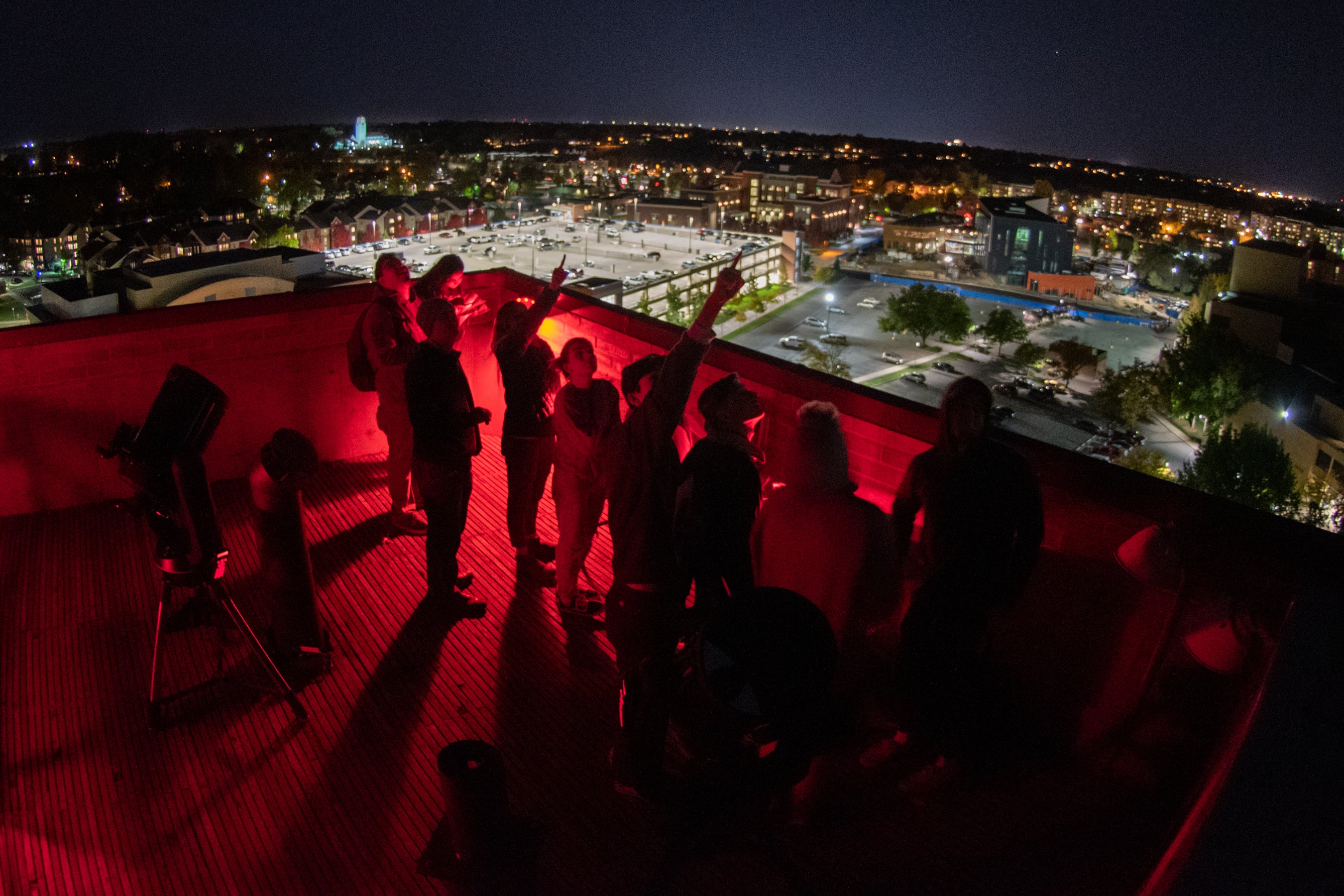
Bronco Day 2023 happened to coincide with an annular solar eclipse – that’s when the Moon blocks the center of the Sun, leaving a bright ring of sunlight in the sky. Boise State’s physics department and Brian Jackson, a professor of astronomy, transformed the Student Union Intramural Field into a grassy observatory for the day, providing eclipse viewing safety glasses and educational materials. Jackson and the department are devoted to public outreach and making physics and astronomy more accessible to learners of all ages.
“Over the last several years, Boise State’s astronomy program has grown by leaps and bounds, and it’s really thanks to the hard work of our staff, the untiring support of the public, and the infectious curiosity of our physics students. It’s been very gratifying to work with and for such a dedicated community,” Jackson said.
In that spirit, Jackson and the department are spreading the word about events that interweave science with art and music and more.
Public events include:
NOTE: “JOURNEY THROUGH THE TRAPPIST-1 SYSTEM” HAS BEEN POSTPONED AS OF 9/25. WATCH FOR UPDATES.
“Journey through the TRAPPIST-1 System”: 4-7 p.m., Sept. 27 in the Boise State Stein Luminary, an opening event with student composers. Exhibition continues for First Thursday, 5-8 p.m., Oct. 3 and from 4-7 p.m., Oct. 8, then from 10 a.m.-2 p.m., Monday-Friday through Oct. 26 (except when closed for classes).
This collaborative project includes the departments of music, art, design, and visual studies and physics and faculty members Brian Jackson, Ryan Donahue and Eric Alexander. Music composed by Boise State music composition students and interactive visuals by Donahue, a visiting professor of graphic design, will take visitors on an aural and visual journey inspired by TRAPPIST-1, a red dwarf star located about 40 light-years away from Earth in the constellation Aquarius. It’s notable for having a system of seven Earth-sized exoplanets in its orbit. These planets, discovered in 2016, are of particular interest because they lie in the star’s habitable zone where conditions might allow water to exist on their surfaces – hinting at a potential to host life. Student composers created movements representing the planets, then performed and recorded their pieces with help from community musicians.
The 2024 Carl Sagan Prize Medal public lecture with Jamie Molaro, “A Portrait of the Artist as a True Scientist”: 7 p.m., Oct. 8 at Boise State Special Events Center.
Molaro, a research scientist at the Planetary Science Institute in Arizona and the Caltech/Jet Propulsion Laboratory, is also an artist and musician and a co-founder founder of “The Art of Planetary Science,” an annual art exhibition hosted by UArizona’s Lunar and Planetary Laboratory that celebrates the beauty and elegance of science. The outreach project, created by Molaro and a fellow scientist/artist when she was a graduate student, presents a multi-faceted view of science. It invites scientists to produce artwork for the show inspired by data and ideas, illustrating interconnection between scientific and artistic processes.
For her blog, Data Arcana, Molaro wrote, “As planetary scientists, our research focuses on some of the most beautiful and awe-inspiring things in the universe, and yet as scientists, we don’t often take the opportunity to express this to others. Often, the beauty we see every day in our work is obscured in equations, numbers, and graphs. When I create a plot from my research analysis, it may only look like a bunch of dots and lines to most people. To me, however, it’s beautiful because it has context, and meaning, and implications for the way that we understand the universe.”
Molaro’s lecture, free and open to the public, is part of the 56th annual meeting of The American Astronomical Society’s Division for Planetary Science in Boise, Oct. 6-10.
John Mather, First Friday Astronomy: 7:30 p.m., Nov. 1, Student Union Jordan Ballroom.
The physics department offers a series of First Friday Astronomy events that bring celebrated speakers to campus each month and offer stargazing at the campus observatory. This visit is from Nobel Prize-winning astrophysicist John Mather, known for his groundbreaking work on the Cosmic Background Explorer project and as lead project scientist for the James Webb Space Telescope.
The event is free, but the department will invite donations to upgrade Boise State’s 50-year-old astronomical observatory atop the Education Building. The observatory, a key part of astronomy outreach at the university, is in the midst of a crowdfunding campaign. Read more about the observatory and these efforts in a recent feature on Boise State’s news website.
More educational outreach
In 2023, NASA donated $125,000 to Boise State’s Telescopes for Teachers program to buy 50 telescopes. Boise State’s Central Idaho Dark Sky Reserve STEM Network team is distributing them to Idaho classrooms and providing training for teachers and encouraging citizen scientists. Each telescope is named for an influential woman in science. The program launched in summer 2024. Rachel Huchmala, a postdoctoral research fellow at Boise State, is distributing telescopes and hosting teacher workshops. Read more on the Telescopes for Teachers website.